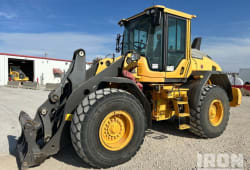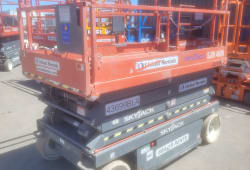Importance of Personal Protective Equipment (PPE) for Heavy Equipment Operators
14 Lectura mínima
)
agosto 11, 2023
Heavy equipment operators play a crucial role in various industries, such as construction, mining, and transportation. These operators are exposed to numerous risks and hazards daily, making personal protective equipment (PPE) a vital component of their safety measures. Understanding the importance of PPE and ensuring its proper use and maintenance can significantly enhance operator safety and mitigate potential injuries or fatalities.
Understanding the Importance of PPE for Heavy Equipment Operators
Heavy equipment operators face various occupational hazards, including falling objects, noise pollution, airborne particles, and exposure to hazardous chemicals. PPE serves as the first line of defense against these hazards, providing protection for the operator's head, face, hearing, respiratory system, hands, and arms, as well as their feet and legs.
PPE acts as a physical barrier between the operator and potential hazards, reducing the risk of injuries or illnesses. It plays a critical role in safeguarding an operator's well-being, ensuring they can perform their tasks with confidence and minimal harm.
When it comes to heavy equipment operations, safety should always be a top priority. The use of personal protective equipment (PPE) is not just a recommendation, but a necessity. Let's delve deeper into the role of PPE in ensuring operator safety and the legal requirements that govern its use.
The Role of PPE in Ensuring Operator Safety
One of the primary purposes of PPE is to prevent accidents and injuries. Equipment malfunction, falling debris, or sudden impacts can lead to severe head injuries. By wearing properly fitted and approved head protection, such as hard hats, heavy equipment operators can reduce the risk of head trauma, concussions, and other serious injuries.
But it's not just the head that needs protection. Heavy equipment operators are also exposed to high levels of noise during their work. The constant roar of engines and the clanking of metal can take a toll on their hearing. Prolonged exposure to high noise levels can cause hearing loss or impairment. To mitigate this risk, operators should wear hearing protection, such as earmuffs or earplugs, to minimize noise exposure and safeguard their hearing.
Additionally, heavy equipment operators often encounter hazardous substances in their work environment. These substances can include chemicals, dust, or other airborne particles that can pose a threat to their respiratory system. Wearing respiratory protective equipment, such as masks or respirators, can help filter out these harmful substances, ensuring the operator breathes in clean and safe air.
Legal Requirements for PPE in Heavy Equipment Operations
In many jurisdictions, laws, and regulations governing the use of PPE in heavy equipment operations. Employers are legally obligated to provide suitable PPE to their operators and ensure its proper use. Failure to comply with these regulations can result in penalties and legal consequences. These laws are in place to protect operators, their colleagues, and the integrity of the workplace.
Furthermore, employers must also provide training and education on the proper use and maintenance of PPE. This includes instruction on how to inspect and test equipment, as well as how to properly clean and store it. By ensuring that operators are knowledgeable about PPE, employers can create a safer work environment and reduce the risk of accidents and injuries.
In conclusion, PPE is not just a piece of equipment; it is a crucial aspect of heavy equipment operations. It plays a vital role in ensuring operator safety by protecting against various hazards. Employers must prioritize the provision and proper use of PPE to comply with legal requirements and create a safe work environment for their operators. By understanding the importance of PPE and adhering to regulations, heavy equipment operators can perform their tasks with confidence, knowing that their well-being is safeguarded.
Types of Personal Protective Equipment for Heavy Equipment Operators
There are several essential categories of PPE for heavy equipment operators, each designed to address specific hazards and protect different parts of the body.
When it comes to heavy equipment operations, safety should always be a top priority. Operators face numerous risks and potential hazards, making the use of personal protective equipment (PPE) crucial. In this article, we will explore the different types of PPE available for heavy equipment operators and their importance in ensuring a safe working environment.
Head and Face Protection
Head and face protection is crucial in heavy equipment operations due to the potential for falling objects, impacts, and flying debris. Hard hats are the most common form of head protection, shielding operators from falling objects, low beams, or protruding structures. These sturdy helmets are designed to absorb and distribute the force of an impact, reducing the risk of head injuries.
Additionally, face shields or safety glasses provide added protection against flying particles, dust, and chemical splashes. Face shields offer full-face coverage, ensuring that the operator's eyes, nose, and mouth are shielded from any potential hazards. Safety glasses, on the other hand, are lightweight and comfortable, making them ideal for tasks that require precision and clear vision.
Hearing Protection
Heavy equipment can generate excessive noise levels, posing a significant risk to operators' hearing. Employing hearing protection, such as earmuffs or earplugs, is essential to minimize the risk of hearing loss or impairment. These protective devices are designed to reduce the intensity of noise entering the ear, providing a safer and more comfortable working environment for operators.
By reducing noise exposure, operators can maintain their hearing health and ensure effective communication in the workplace. Clear communication is vital in heavy equipment operations, as it allows operators to coordinate their movements and respond quickly to any potential dangers or emergencies.
Respiratory Protection
In heavy equipment operations, operators may encounter hazardous airborne substances, such as dust, fumes, or chemicals. Respiratory protection in the form of masks or respirators helps filter out these contaminants, preventing respiratory system damage or illnesses. Operators must wear the appropriate respiratory protective equipment to safeguard their health.
Proper fit and regular replacement of respiratory protective equipment are essential to ensure its effectiveness. Operators should undergo proper training on how to use and maintain these devices, as well as recognize the signs of wear and tear. By following these guidelines, operators can breathe easily while performing their duties.
Hand and Arm Protection
Heavy equipment operators frequently handle sharp objects, operate machinery with potential pinch points, or work in harsh weather conditions. Gloves protect against cuts, abrasions, punctures, or thermal hazards, offering comfort and grip while ensuring hand safety. Operators should choose gloves suitable for their specific tasks and regularly inspect them for damage.
Gloves come in various materials and designs, each catering to different hazards and tasks. For example, cut-resistant gloves are ideal for tasks involving sharp objects, while thermal-resistant gloves protect against extreme temperatures. By wearing the appropriate gloves, operators can minimize the risk of hand and arm injuries, ensuring their safety and productivity on the job.
Foot and Leg Protection
Foot and leg protection, such as steel-toed boots, helps safeguard operators against potential crushing injuries or impacts from heavy equipment or falling objects. These sturdy boots are reinforced with a protective steel cap, providing an additional layer of safety for the feet.
Operators must wear appropriate footwear that offers stability, protection, and slip resistance, reducing the risk of foot or leg injuries in the workplace. Slip-resistant soles are particularly important, as heavy equipment operators often work in challenging terrains or environments where traction is essential.
Furthermore, operators should ensure that their boots fit properly and provide adequate ankle support. Ill-fitting footwear can lead to discomfort, blisters, or even accidents. Regular inspection and maintenance of boots are also crucial to identify any signs of wear and tear that may compromise their protective capabilities.
In conclusion, personal protective equipment is an indispensable aspect of heavy equipment operations. By wearing the appropriate PPE, operators can minimize the risk of injuries and create a safer working environment. Head and face protection, hearing protection, respiratory protection, hand and arm protection, as well as foot and leg protection, are all vital components of a comprehensive PPE program. Prioritizing safety through the use of PPE ensures that heavy equipment operators can carry out their duties effectively and with peace of mind.
Proper Use and Maintenance of PPE
While procuring and providing appropriate Personal Protective Equipment (PPE) is crucial, proper use and maintenance are equally important for effective protection. In this section, we will delve deeper into the correct fitting, regular inspection and replacement, as well as the cleaning and storing of PPE.
Correct Fitting of PPE
PPE only provides optimal protection when worn correctly and sized appropriately for each operator. Let's take a closer look at some specific types of PPE and their proper fitting:
Helmets should fit securely and comfortably on the head, with adjustable straps ensuring a snug fit. This not only prevents the helmet from falling off during work but also provides stability and reduces the risk of head injuries.
Face shields and safety glasses should cover the eyes fully and form a seal against the face. This ensures that no hazardous substances or particles can enter through gaps, protecting the eyes from potential harm.
Gloves, boots, and other equipment should fit well but still allow for freedom of movement. Gloves that are too tight may restrict hand movements, while loose-fitting boots can lead to discomfort or accidents. Striking the right balance is essential.
Regular Inspection and Replacement of PPE
Operators must regularly inspect their PPE for signs of wear, damage, or deterioration. This proactive approach is crucial in maintaining the effectiveness of the equipment. Here are some key points to consider:
Helmets should be carefully examined for cracks or compromised integrity. Even the smallest crack can significantly reduce their ability to protect against impact. Any helmets showing signs of damage should be replaced immediately.
Safety glasses or face shields should also be inspected for scratches that impair vision. Clear visibility is essential in maintaining a safe working environment, and any impaired vision can lead to accidents. Scratched safety glasses or face shields should be promptly replaced.
Earmuffs or earplugs should seal against the ears properly to provide adequate hearing protection. Operators should ensure that their hearing protection equipment is functioning correctly and free from any defects.
Gloves should be checked for holes or tears that can compromise their protective capabilities. Any damaged gloves should be replaced to ensure the safety of the wearer.
Boots should also be inspected for any signs of wear or compromised soles. Damaged boots can lead to discomfort or loss of stability, increasing the risk of accidents. Replacing boots with compromised integrity is essential for maintaining a safe working environment.
Operators should follow the manufacturer's recommendations regarding the lifespan of each PPE item and proactively replace any equipment that no longer provides adequate protection. Regularly reviewing and updating PPE is crucial in ensuring the ongoing safety of workers.
Cleaning and Storing PPE
Proper cleaning and storage of PPE are essential in maintaining its longevity and functionality. Here are some guidelines for cleaning and storing different types of PPE:
Operators should clean reusable PPE, such as gloves or face shields, according to the manufacturer's instructions or industry best practices. Proper cleaning removes any contaminants that may have accumulated during use, ensuring that the equipment remains effective and safe to use.
Respiratory protection, such as masks or respirators, should undergo regular cleaning or replacement as recommended by the manufacturer. This is crucial in maintaining their effectiveness in filtering out harmful particles and ensuring the operator's respiratory health.
PPE should always be stored in a clean and dry area, away from exposure to extreme temperatures, sunlight, chemicals, or other potentially damaging substances. Storing PPE properly helps to prevent deterioration and prolongs its lifespan, ensuring that it remains in optimal condition for future use.
By following these guidelines for cleaning and storing PPE, operators can maximize the lifespan of their equipment and maintain its effectiveness in providing protection.
Training for Effective Use of PPE
Proper training is a fundamental aspect of PPE implementation and effective use in heavy equipment operations. Without adequate training, operators may not fully understand the importance of personal protective equipment and how to use it correctly, which can lead to serious accidents and injuries.
When it comes to heavy equipment operations, there are various hazards that operators may encounter daily. These hazards can range from falling objects and flying debris to exposure to harmful chemicals and extreme temperatures. By providing comprehensive PPE training, operators can gain the necessary knowledge and skills to identify these hazards and protect themselves accordingly.
Importance of PPE Training
PPE training equips operators with the necessary knowledge and skills to identify hazards, understand proper PPE selection, use, and maintenance procedures, and adapt to changing workplace conditions. It is not enough to simply provide operators with the required PPE; they must also be trained on how to use it effectively.
During PPE training, operators learn about the different types of PPE available and their specific purposes. For example, they may learn about the importance of wearing safety helmets to protect against head injuries or the significance of wearing safety glasses to shield their eyes from flying debris. By understanding the purpose of each type of PPE, operators can make informed decisions about which equipment to use in different situations.
Furthermore, PPE training emphasizes the importance of PPE compliance and personal responsibility in ensuring operator safety and the safety of those working around them. Operators learn that wearing PPE is not just a requirement, but a crucial step in preventing accidents and protecting themselves and their colleagues from harm.
Key Elements of PPE Training
PPE training should include comprehensive instruction on the various types of PPE, their specific purposes, and proper use. Operators should learn how to correctly fit and inspect their PPE to ensure its effectiveness. Proper fitting is essential to ensure that the PPE provides adequate protection and does not hinder the operator's movement or vision.
In addition to fitting and inspection, identifying potential hazards and understanding the consequences of neglecting PPE are crucial components of training. Operators should be trained to recognize potential hazards in their work environment and understand the risks associated with not using the appropriate PPE. This knowledge helps operators make informed decisions about when and how to use PPE, ensuring their safety in various situations.
Moreover, PPE training should also cover the maintenance and care of PPE. Operators should be educated on how to clean, store, and maintain their PPE to ensure its longevity and effectiveness. Regular inspection and replacement of damaged or worn-out PPE are essential to ensure continuous protection.
In conclusion, proper training is vital for the effective use of PPE in heavy equipment operations. By providing operators with comprehensive instruction on PPE selection, use, and maintenance, they can develop the necessary skills to protect themselves from workplace hazards. PPE training not only enhances operator safety but also promotes a culture of responsibility and awareness in the workplace.
Case Studies: The Impact of PPE on Operator Safety
Real-life case studies demonstrate the significant impact that proper PPE use can have on operator safety in heavy equipment operations.
Case Study 1: Improved Safety with Proper PPE Use
At a construction site, an operator wearing a hard hat and steel-toed boots narrowly avoided a serious head injury and foot fracture when a small object fell from above. The incident highlighted the importance of the operator's PPE, which successfully protected them from potential harm.
Case Study 2: Consequences of Neglecting PPE
In another situation, an operator failed to wear hearing protection while operating a noisy machine over an extended period. As a result, they experienced significant hearing loss, impacting both their personal and professional life. This case underscores the severe consequences of neglecting PPE and serves as a stark reminder of the importance of proper protection.
Future Trends in PPE for Heavy Equipment Operators
As technology advances and safety regulations evolve, the future of PPE for heavy equipment operators looks promising.
Technological Advancements in PPE
Emerging technologies, such as smart helmets, are being developed to enhance PPE functionality. These advanced helmets integrate sensors and communication systems to provide real-time data on the operator's vital signs, exposure levels, and potential dangers. Such advancements optimize safety, allow for remote monitoring, and provide early alerts to potential hazards.
Increasing Awareness and Regulations for PPE Use
As governments and organizations emphasize workplace safety, the awareness and importance of PPE continue to grow. Improved regulations and standards are being established to ensure comprehensive protection for heavy equipment operators. Employers are becoming more proactive in implementing robust PPE programs that prioritize the safety and well-being of their workforce.
In conclusion, personal protective equipment (PPE) plays a crucial role in ensuring the safety of heavy equipment operators. Understanding the importance of PPE and adhering to proper use, maintenance, and training guidelines can significantly mitigate the risks operators face daily. As technology advances and safety becomes increasingly prioritized, PPE will continue to evolve, optimizing operator safety and exemplifying its vital role in heavy equipment operations.

Post acquisition of Boom & Bucket, the company he founded, Adam now leads Marketplace Growth for Ritchie Bros.














